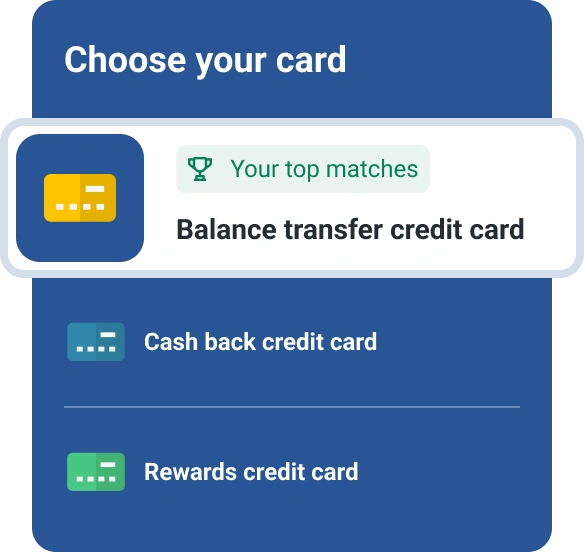What Are Balance Transfer Credit Cards?
Quick Answer
Balance transfer credit cards offer a temporary low or 0% intro APR on balances you transfer to the card. You can use one to consolidate high-rate debt, lower your monthly payment and save money. But consider the requirements, pros, cons and alternatives.

A balance transfer credit card is any card that offers a promotional interest rate on transferred balances. These types of offers come and go, and you might find one on rewards cards, travel cards or low-interest credit cards. Cards are often categorized as balance transfer cards when they offer perks to new cardholders who transfer a balance.
How Do Balance Transfers Work?
A balance transfer is when you use a credit card account to pay down (or pay off) another credit card's balance. For example, when you transfer a balance between credit cards, you're asking one credit card issuer to send a payment to one of your credit card accounts.
You might receive a balance transfer offer on a new or existing credit card, giving you a low or 0% promotional annual percentage rate (APR) on the balances you transfer to the card. If you transfer balances that are accruing interest at a higher rate, the balance transfer can lower your monthly payments and save you money overall.
Common Balance Transfer Terms to Know
There are a few key balance transfer terms you'll want to learn and understand if you're considering using a balance transfer offer:
- Balance transfer fee: Credit cards may charge a balance transfer fee on the amount you transfer to the card. Major card issuers often charge 3% or 5%, but you may be able to find cards from smaller credit unions that don't have this fee.
- Balance transfer limit: Your account may have a balance transfer limit that's lower than the card's overall credit limit. You generally won't know your limit until after you apply and are approved for the card.
- Balance transfer APR: The balance transfer APR is the promotional APR that applies to the eligible balances you transfer. It's often a very low or 0% intro APR.
- Promotional purchase APR: Some balance transfer cards also offer a promotional APR on purchases. If the card doesn't have an intro 0% purchase APR, new purchases might start to accrue interest immediately.
- Initial period: Be sure to review the balance transfer offer to see how long you have to request or complete a transfer. For example, you might only receive the balance transfer APR on balances that are transferred to the card within the first 60 days.
- Promotional period: The promotional period is the limited time when your balances receive the promotional balance transfer APR. Depending on the offer, this might last around nine to 21 months.
- Standard APR: Once the promotional period ends, any remaining balances will start to accrue interest based on the card's standard APR. The rate may depend on your creditworthiness and changes in a benchmark interest rate.
Pros and Cons of Balance Transfer Credit Cards
Although each balance transfer offer may have its own particular pros and cons, there are also general pros and cons to consider before applying for a balance transfer card or using a balance transfer offer.
Pros
- Accrue less interest: Moving high-interest credit card balances to a card that has a low or 0% intro APR could significantly decrease how much interest accrues each month. You can put the savings toward paying off the balance faster, paying down other high-rate debts or covering other expenses.
- Consolidate debts: You can transfer balances from multiple accounts to a single card to consolidate your debt. Having fewer accounts and bills to manage can simplify your finances and free up time.
- Transfer non-credit card balances: Some cards let you transfer balances from loans or transfer a balance to your bank account. You can then use the low or 0% into APR offers to pay off other types of debts or finance purchases.
Cons
- Potential fees: Balance transfer fees can increase your total balance at the start and offset some of the potential savings that come from the lower interest rate.
- Limitations on transfers: You generally can't transfer balances between cards from the same issuer, and your balance transfer limit might not be high enough to include all the balances you'd like to transfer.
- Doesn't address overspending: Transferring balances and freeing up your existing credit limits won't necessarily help if you have credit card debt because of compulsive spending or overspending. You might wind up deeper in debt if you don't address the underlying causes of your debt.
- May require a high credit score: You might need to have a good credit score to qualify for a balance transfer offer and receive a helpful balance transfer limit. According to the Consumer Financial Protection Bureau's 2023 Consumer Credit Card Market report, 98% of balance transfer volume was by consumers who had a credit score of 660 or higher.
How to Choose a Balance Transfer Card
Choosing the right balance transfer card will depend on how you plan to use the card and the current balance transfer offers. Consider the following:
- The offer's terms: Review the balance transfer offer's balance transfer fee, balance transfer APR and promotional period and try to calculate your potential savings. The best option will depend on how much you can afford to pay each month.
- APR offers on purchases: If you want to consolidate all your balances and spending on one account, you might want to open a card that also has a 0% intro APR on purchases. Factor this extra spending on purchases into your debt payoff plan.
- Your long-term plans for the card: You can use a credit card to transfer and pay off balances and then close the card. But if you'd prefer to keep the card open, look for a card that offers cardholder benefits, such as rewards, purchase protections and insurance.
You'll also want to consider your credit score because it can impact your eligibility for various cards. You can use an Experian account to check your credit score for free and get matched with balance transfer offers based on your credit profile.
How to Do a Balance Transfer
Once you find a good balance transfer offer, completing the balance transfers could be a fairly quick and easy process:
- Request a balance transfer when you apply. You might be able to request balance transfers when you apply for the new credit card by listing the other account numbers and the transfer amounts. If you're approved, your transfer requests may be processed in the order you listed them, but it might take several weeks for the credit issuers to execute the transfers.
- Request a balance transfer to an existing card. You can also wait until your account is open and then request a balance transfer online, over the phone or via the mobile app. It may still take several days for the card issuer to process your requests.
- Use a convenience check. Some card issuers offer balance transfer checks that you can use to pay down balances or deposit money into your bank, but review the fine print before using them. Sometimes the checks are considered cash advances rather than balance transfers.
- Monitor your accounts. It can take several days or weeks for your credit card issuer to send a payment to the other creditors, and for them to process the payment. Continue monitoring your accounts for at least two billing cycles to make sure you don't have any remaining balances or residual interest that could lead to a late payment if you miss the bill.
After successfully transferring the balances to your new card, you may want to set yourself up to pay off the balance before the end of the promotional period. For example, if you need to pay $400 each month, you could set up autopay to make a $400 monthly payment.
Alternatives to Balance Transfer Cards
If a balance transfer card doesn't seem like a good idea, or you don't think you'll get approved for a new card with a high balance transfer limit, you could also look into several alternative tools and strategies.
- Debt consolidation loan: You could try to get a low-rate installment loan and use the money to pay off credit card balances. Many people do this with debt consolidation loans, which are unsecured personal loans, but you could also look into home equity loans and 401(k) loans.
- Debt management plan: Credit counseling organizations may be able to enroll you in a debt management plan (DMP) and negotiate with your credit card issuers to waive fees, bring past-due accounts current and lower your interest rates. With a DMP, you'll make a single monthly payment to the credit counselor, who then distributes funds to your creditors. You may be required to stop using credit cards and close accounts. However, DMPs often lead to paying off the cards within three to five years and could result in thousands of dollars in savings.
- Debt payoff strategy: Even if you're not using any new accounts or outside guidance, you could take a strategic approach to paying off your balances. For example, the avalanche and snowball debt payoff methods involve making a list of all your accounts and then focusing on the account with the highest interest rate or lowest balance, respectively.
Everyone's financial situation and goals are different, so you'll have to explore the options and figure out what works best for you.
Frequently Asked Questions
Compare Balance Transfer Offers
Balance transfer offers can change at any time, but Experian can help you review and compare some of the top balance transfer cards and offers. If you create and log in to your Experian account, you can also check and monitor your credit history and score for free. And you can get matched with credit card offers based on your unique credit profile.
Best balance transfer cards
Need to consolidate debt and save on interest? See if you qualify for intro offers like 0% intro APR up to 21 months based on your FICO® Score.
See your offersAbout the author
Louis DeNicola is freelance personal finance and credit writer who works with Fortune 500 financial services firms, FinTech startups, and non-profits to teach people about money and credit. His clients include BlueVine, Discover, LendingTree, Money Management International, U.S News and Wirecutter.
Read more from Louis

